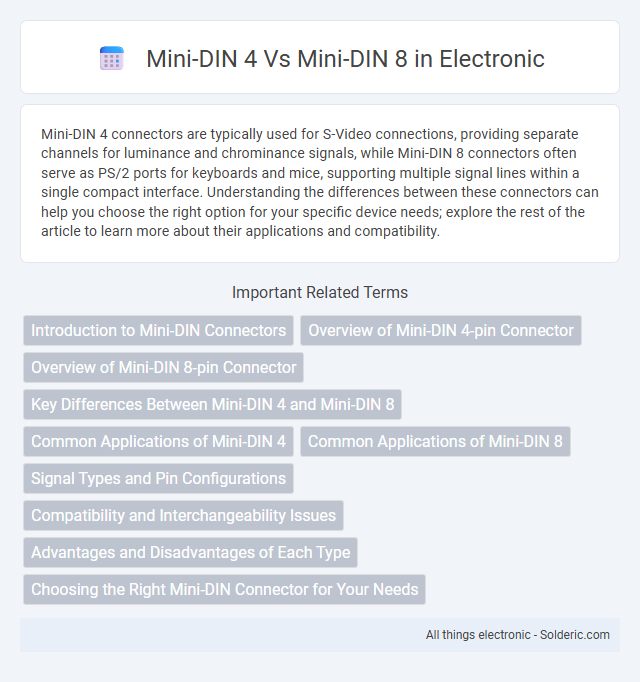Mini-DIN 4 connectors are typically used for S-Video connections, providing separate channels for luminance and chrominance signals, while Mini-DIN 8 connectors often serve as PS/2 ports for keyboards and mice, supporting multiple signal lines within a single compact interface. Understanding the differences between these connectors can help you choose the right option for your specific device needs; explore the rest of the article to learn more about their applications and compatibility.
Comparison Table
| Feature | Mini-DIN 4 | Mini-DIN 8 |
|---|---|---|
| Pin Count | 4 pins | 8 pins |
| Common Use | S-Video connections | Keyboards, mice, audio/video devices |
| Connector Diameter | 9.5 mm | 9.5 mm |
| Signal Type | Analog video (Y/C) | Digital and analog signals |
| Compatibility | S-Video output devices | Legacy computer peripherals, AV equipment |
Introduction to Mini-DIN Connectors
Mini-DIN connectors are circular electrical connectors with a keying pattern designed for specific pin configurations, commonly used in computer and audio/video equipment. Mini-DIN 4 features 4 pins arranged in a distinct pattern for devices such as S-Video connections, while Mini-DIN 8 contains 8 pins suited for applications like keyboard and mouse interfaces. Understanding the pin counts and compatibility helps ensure your devices connect correctly and function reliably.
Overview of Mini-DIN 4-pin Connector
Mini-DIN 4-pin connectors are commonly used for transmitting audio and video signals, such as in S-Video cables, offering reliable analog signal quality with a compact design. Compared to the Mini-DIN 8-pin connector, which supports more complex interfaces like PS/2 keyboards and mice, the 4-pin variant is simpler and less versatile but ideal for specific AV applications. Your choice depends on the required pin configuration and device compatibility for effective connectivity.
Overview of Mini-DIN 8-pin Connector
The Mini-DIN 8-pin connector features eight contact points arranged in a circular pattern, widely used for S-video and Apple Desktop Bus (ADB) interfaces, enabling high-quality video and peripheral connections. Compared to the Mini-DIN 4-pin, which is primarily used for S-video only, the 8-pin variant supports more complex data transmission and multiple device connections. Its compact design and secure locking mechanism make it ideal for applications requiring reliable, multi-signal communication in a small form factor.
Key Differences Between Mini-DIN 4 and Mini-DIN 8
Mini-DIN 4 connectors feature 4 pins used primarily for S-Video transmission, enabling separate luminance and chrominance signals for improved video quality. Mini-DIN 8 connectors contain 8 pins and support a wider range of applications, including older Apple desktop bus (ADB) devices and serial communication interfaces. The key difference lies in pin count and functionality, with Mini-DIN 8 offering more versatility and data transmission capacity than Mini-DIN 4.
Common Applications of Mini-DIN 4
Mini-DIN 4 connectors are commonly used for S-video connections, transmitting separate luminance and chrominance signals to enhance video quality on older TVs, DVD players, and video game consoles. These connectors provide a reliable analog interface for devices requiring high-quality video output without audio transmission. Choosing Mini-DIN 4 ensures your multimedia setup maintains superior video clarity in compatible equipment.
Common Applications of Mini-DIN 8
Mini-DIN 8 connectors are commonly used in legacy computer systems, particularly for connecting keyboards and mice in older Apple Macintosh models and some PC setups. These connectors also serve in various audio and video equipment, providing reliable multi-pin connections for devices such as MIDI instruments and certain broadcast gear. Compared to Mini-DIN 4, which is often found in S-Video cables, Mini-DIN 8 offers more pins for increased functionality and versatility in data and signal transmission.
Signal Types and Pin Configurations
Mini-DIN 4 connectors typically support S-Video signals, consisting of separate luminance and chrominance channels transmitted over four pins. Mini-DIN 8 connectors accommodate more complex protocols, including PS/2 keyboard and mouse interfaces or Audio/Video signals, utilizing eight pins for diverse data, clock, ground, and signal lines. The pin configuration differences dictate compatibility, with Mini-DIN 4 focusing on video clarity and Mini-DIN 8 providing versatile connectivity for multiple device functions.
Compatibility and Interchangeability Issues
Mini-DIN 4 connectors, typically used for S-video signals, offer limited compatibility with the more versatile Mini-DIN 8 connectors, which support various applications including PS/2 keyboard and mouse interfaces. Interchanging Mini-DIN 4 with Mini-DIN 8 is generally not feasible due to differing pin arrangements and signal protocols, leading to potential damage or malfunction. Devices requiring specific Mini-DIN pin configurations must use the correct connector type to ensure proper functionality and avoid compatibility issues.
Advantages and Disadvantages of Each Type
Mini-DIN 4 connectors offer a compact design and are commonly used for S-video connections, providing clear video signals with separate luminance and chrominance channels, but their limited pin count restricts functionality to basic video transmission. Mini-DIN 8 connectors accommodate more pins, enabling support for additional signals such as audio or power alongside video, which makes them versatile for multi-function devices, yet their larger size may be less suitable for compact applications. The choice between Mini-DIN 4 and Mini-DIN 8 depends on the specific device requirements and the need for additional signal lines versus space constraints.
Choosing the Right Mini-DIN Connector for Your Needs
Choosing the right Mini-DIN connector depends on your device's port configuration and signal requirements, with Mini-DIN 4 commonly used for S-Video connections providing separate luminance and chrominance signals. Mini-DIN 8 offers more pins, supporting complex data transmission such as PS/2 keyboard and mouse interfaces or multi-channel audio, making it adaptable for devices needing additional connectivity. Your selection should consider the number of pins required and the specific data or video signals to ensure compatibility and optimal performance.
Mini-DIN 4 vs Mini-DIN 8 Infographic

 solderic.com
solderic.com